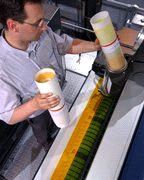Consumables
Saphira Consumables from Heidelberg Focus on Eco-Friendly Ink Supply Systems

Tuesday 10. June 2008 - InkLine becomes InkStar Ink cartridges made from recycled materials Two-stage system for cutting and shredding cartridges cuts waste volumes by up to 70 percent
During drupa 2008, Heidelberger Druckmaschinen AG (Heidelberg) is expanding its Saphira range of consumables with the launch of an extended system solution for its InkLine automated ink supply system, which will be renamed InkStar. The new solution includes InkStar cartridges made from recycled materials, and Heidelberg is also introducing a two-stage cutting and shredding system for the disposal of empty cartridges that helps cut waste volumes by up to 70 percent.
Heidelberg launched InkLine in 1998 and since then has installed over 16,000 units around the world, even under license on presses from competitors. Due to its outstanding level of automation, InkLine reduces the workload of press operators and helps raise productivity levels significantly. What is more, InkLine also saves money and protects the environment as it leaves only around ten grams (less than half an ounce) of residual ink in the two-kilogram (around four pounds seven ounces) ink cartridges. By way of comparison, a used 2.5 kilogram (around five pounds eight ounces) ink can often contain more than 100 grams (3.5 ounces) of residual ink.
Ink cartridges made from recycled materials
The range of inks marketed globally by Heidelberg under the Saphira brand is to be extended so that print shops in Europe have access to composite cartridges as well as the two-kilogram plastic-only containers currently available. Composite cartridges have a plastic valve and plunger and a cardboard cylinder that is almost entirely made from recycled paper.
Thanks to extensive testing and direct customer support, Heidelberg has successfully launched both cartridge types in the relevant markets and will be showcasing them at drupa 2008 with “Saphira” inks.
Due to the widely varying legal and official regulations that apply for the disposal of used ink cartridges in different countries, it is important that print shops can choose between the two types of cartridge.
Reaping financial rewards from waste
Besides developing cartridge materials that can be produced and disposed of in an environmentally friendly manner, Heidelberg has also worked hard to reduce waste volumes. During drupa 2008, the company will be exhibiting a two-stage system consisting of a cartridge valve cutting device and a cartridge shredder. The system, which is based on a technology developed for the recycling of waste paper and electronic scrap, has already proven its worth in several print shops.
By shredding cartridges print shops can reduce their waste volume by up to 70 percent. This in turn cuts outlay on transport logistics and conserves energy resources.
The first stage involves the cartridge valve cutting device separating the valve section containing the residual ink and the plunger. All that is left is the cartridge cylinder, which is broken down into chips measuring approximately four by two centimeters (1.57 x 0.79 inches) in the cartridge shredder.
The valve section containing residual ink usually undergoes thermal recycling. The cartridge cylinders in plastic cartridges are usually so clean that they can be sold as high-quality recycling plastic once they have been shredded, which offers print shops an interesting opportunity given the high price of oil. The cartridge cylinder of the composite cartridges can also be shredded and then fed directly into the paper waste or the waste paper recycling process.
